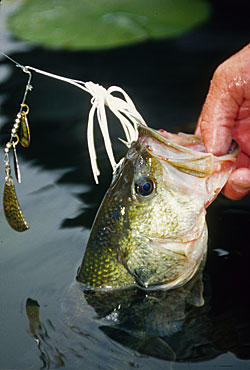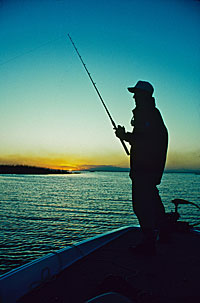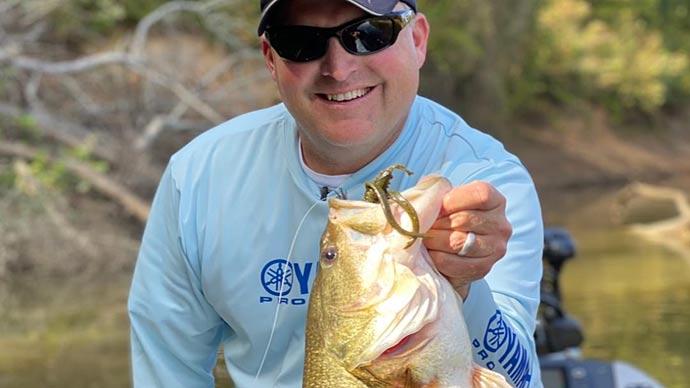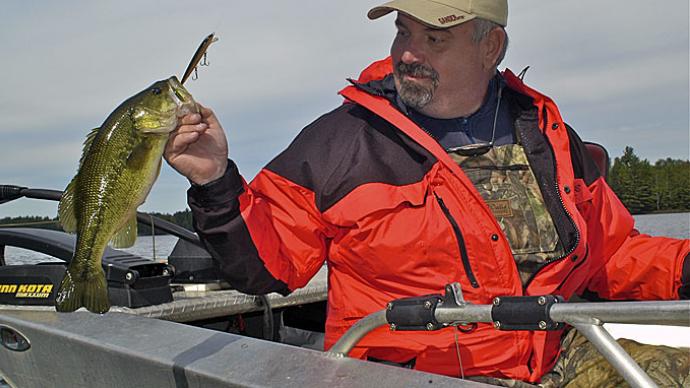
Nebraska is certainly not a state that comes to mind when you think of premier largemouth bass fishing. But the Cornhusker State has some surprisingly shocking largemouth fishing in places that would be considered more ponds than lakes. These modest reservoirs, small lakes, ponds, and gravel pits see minimal fishing pressure and routinely produce 5- to 6-pound bucketmouths. NE has big-bass potential.
“Most big bass, at least largemouths, caught in Nebraska are caught from smaller lakes and ponds,” shared NGF&P Fisheries Biologist Dave Tunink. “Take Burchard Lake, for example. It’s only 150 acres, but it’s got some good bass in it, and they occasionally have tournaments on there. Summit Reservoir near Tekamah is another one. It’s not 200 acres, but it’s got some pretty good largemouths. There are probably a hundred or more lakes and reservoirs like that scattered across Nebraska, especially eastern Nebraska. Heck, the state record largemouth was caught from a gravel pit.” That bucketmouth tipped the scales at 10 pounds 11 ounces. Big things do come in small packages.
Most of these smaller bodies of water don’t get overwhelmed with weeds, as you might think. According to Tunink, few of these smaller waters are clear enough to have excessive weed growth. Some good examples are the I-80 lakes excavated when the expressway was built. These smaller ponds feature good access, are easy to fish, and give up some exceptional bass throughout the year.
Urban Reservoirs

The state's eastern third has many waters that produce excellent bass fishing. The waters there are less prone to drought and usually are not used for irrigation. They range from smaller ponds to larger reservoirs. Many are only a short drive from Nebraska’s biggest cities. Look for Wehrspann, Zorinsky, Standing Bear, and Glen Cunningham to provide easy access and excellent fishing for largemouth bass in the Omaha area. Lincoln is ringed with great bass reservoirs, including Wagon Train, Stagecoach, Bluestem, Olive Creek, Yankee Hill, Conestoga, Pawnee, and Branched Oak. All are only a short drive from Cornhusker Central.
Smallmouth bass are not as prevalent in Nebraska as largemouth. There are exceptions. “Enders Reservoir had some good smallmouths in previous years, but years of low water levels have changed that.” Fisheries Biologist Caleb Huber said. He explained that extremely low water levels had hurt most, if not all, of the reservoirs in the Republican River chain. Reservoirs like Enders, Swanson, Medicine Creek, and Red Willow have from ½ to 1/3 the surface area they would at full pool.
Largemouth and smallmouth bass suffer because they don’t have access to the flooded willows, trees, and brush they need for spawning and foraging. All bass species are then confined to smaller open water areas, and eventually, their numbers decline. The low water doesn’t affect pelagic species, like wipers and white bass, as much, but eventually, all species suffer.
Huber said if water levels rebound, look for Red Willow to produce some hot bassin’. “Red Willow is one to watch,” offered Huber. “It was drained to repair the dam there, and once it refills, the fishing should take off,” Huber said they’d likely plant more largemouth in Red Willow to jumpstart the fishery, but it will take several years before anglers see the results.
Lake McConaughy

Lake McConaughy’s bass numbers are booming. “Smallmouth did very well when the water was high,” Robby Rowland said. He is a guide on Lake McConaughy (lakemactopdog.com). “There are more bass in the lake than there’s ever been,” Rowland said to look to the east end of the reservoir and along the south shore for smallmouths and to the west end for largemouths. The west end is warmer, shallower, and has more brush and wood; the east has more rocks. Kingsley Dam is hot for brown bass. You can catch 2- to 4-pound smallies until your arm hurts. 5-pounds largemouth are not uncommon, and the potential for a 7-pound giant is very real. Few people fish for bass on McConaughy. Most are after walleye.
Rowland claims the same lures will catch both species. “You can’t go wrong with a white spinnerbait, tubes, and a black and blue Booyah Boo jig-n-pig,” he said.
There are plenty of wipers and white bass to keep things interesting when fishing McConaughy. “There’s a two-week window in June when the alewives are spawning that the wiper fishing is just stupid,” said Rowland. “The wipers will herd the alewives right up on the rocks. You can throw just about anything, but Rattling Rouge Perfect 10’s or Booyah Double Willow Counter Strike Spinner Baits in white or shad are killer. The fishing gets hot when the water temperature reaches 60 degrees. Early and late in the day is best. Guys catch them in the Arthur and Martin bays in late May when wind pushes the baitfish into the shallows.”
“I’d be willing to bet that there’s a new state-record wiper swimming in Lake McConaughy,” stated Nebraska Fisheries Outreach Program Manager Daryl Bauer.
Merritt Reservoir

“Merritt Reservoir has some humungous bass in it,” claimed Rowland. “4 and 5 pounders are common, mainly largemouths. They claim that there are smallmouths in there, but I’ve never caught one.” Rowland said he’s never seen a place where you can catch good bass as consistently in the shallows. He said he’s caught trophy bass in both the Power Horn and Boardman arms of the reservoir when you find a beaver hut.
“I’ve caught good bass in a foot or two of water even in the heat of July,” Rowland said. The bass gorge on a diet of alewives, shad, frogs, and panfish. Productive baits include 3/8- or ½-ounce white or chartreuse Booyah Vibra Flex or Double Blade Willow spinnerbaits Cotton Cordell Rattle Traps, or Pad Crasher Frogs.
Valentine NWR
The lakes on the Valentine NWR near Valentine, NE, prove that small water bodies can produce exceptional bass. Nine refuge lakes, seven of which have boat ramps, are open to fishing on the refuge. The lakes include Pelican, West Long Lake, Duck, Watts, Hackberry, Dewey, and Clear lakes.

“All of them are shallow with a dark bottom, so they warm up quickly in the spring,” said Rowland. “None are much deeper than 5 feet, so chucking a spinnerbait or twitching a stick bait on the surface can be surreal.” Combustion motors are not allowed on the refuge, so you’ll need to rely on your electric motor if you’re using your bass boat. The refuge lakes are a prime location to take a belly boat or pontoon and kick around. The lakes are ideally suited to those that like to fly fish.
Right after ice-out through early summer is the best time to fish the refuge lakes. Concentrate on the south-facing shorelines or where the wind is piling up the sun-warmed water. Fishing can be good throughout the year, but weeds become a problem as the season progresses. It can be heaven if you’re the kind of guy who revels in fishing the slop with topwater frogs and buzzbaits. You’ll be surprised by some giant northerns, too.
You’ll find accommodations and amenities in Valentine, about 20 miles north of the refuge lakes. Contact the Valentine Chamber of Commerce at visitvalentine.org/contact-us-2/ or call 800-658-4024.
Although they might not be much help, contour maps of the lakes can be found at outdoornebraska.ne.gov/fishing/programs/lakemapping/district2.asp. For information on the Valentine NWR, contact 402-376-3789 or e-mail: Fort Niobrara@fws.gov.
Nebraska does not immediately come to mind when you talk about hawg largemouths. But it should.




